Exploring the Allure of Green Pearls in Gemology
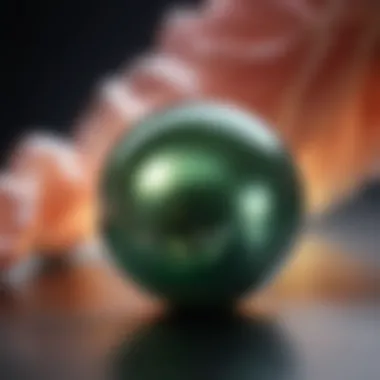

Intro
Green pearls have started to garner attention in the world of gemstones, enticing both collectors and jewelry designers with their unique aesthetics and mysterious origins. Unlike the typical white or black varieties we hear about often, these pearls present a vibrant twist. They remind us that nature’s artistry knows no bounds.
Emerging from the depths of oceans and rivers, green pearls carry a story woven through both geological and cultural history. What truly makes them intriguing is not just their appearance, but the lore and values ascribed to them in various cultures throughout history. This guide aims to peel back the layers of understanding surrounding these fascinating gems, offering insights into their formation, characteristics, and significance in our lives.
Gemstone Overview
Definition and Characteristics
Green pearls, primarily produced by certain species of mollusks, notably the Pinctada margaritifera, captivate with their diverse shades of green. These hues often shift from deep emerald to soft olive, sometimes exhibiting iridescent qualities that catch the eye. Their unique coloration is largely a result of the environment in which they are formed, as well as the oyster’s diet, intertwined with factors like water quality and temperature.
The texture of green pearls can also vary—they may be smooth, with a shiny complexion, or exhibit a more organic, ribbed surface, contributing to their charm. Each pearl tells a different story, showcasing its own characteristics. This individuality fascinates gem enthusiasts and collectors alike.
Classification of Gemstones
Like many gemstones, pearls are classified based on their type, origin, and formation. Understanding the classification helps in identifying the value of each pearl.
- Natural Pearls: Formed spontaneously in the wild, these are rare and carry significant market value.
- Cultured Pearls: Created with human intervention by inserting an irritant into the oyster, these are more common yet still valuable depending on quality.
- Freshwater vs. Saltwater: Green pearls are often sourced from both environments, though saltwater pearls usually have higher luster and roundness.
Properties of Gemstones
Physical Properties
The physical properties of green pearls are what make them stand out in the realm of natural gems. These properties include:
- Luster: Displaying a brilliant sheen, their luster can range from metallic to pearly, influenced by the internal structure of the pearl.
- Coloration: The various shades of green encompass a spectrum that can shift under different lights. Some pearls even exhibit a chatoyant effect, giving them a captivating play of light.
Chemical Properties
Green pearls are primarily made of aragonite, a form of calcium carbonate. They also contain conchiolin, a protein that plays a critical role in the pearl’s growth and structure. In terms of chemical resilience, pearls are relatively sensitive to acids. This inherent trait stresses the importance of careful cleaning and storage, ensuring their beauty endures.
"Green pearls embody both elegance and a touch of nature's extravagance, making them a coveted addition to any gemstone collection."
In wrapping this section up, it’s clear that green pearls are not merely ornamental but also rich in character and complexity. They offer a wonderful glimpse into the relationship between nature and craftsmanship. The exploration does not stop here; we will dive deeper into the cultural significance and market trends surrounding these unique gems.
Stay with us as we unravel more about the allure of green pearls.
Prologue to Green Pearls
The realm of green pearls stands as a testament to nature's artistry, blending beauty with the earthy tones that speak volumes. Understanding the significance of these gems sets the stage for a greater appreciation. This section not only piques curiosity but also highlights why green pearls are worthy of exploration.
Green pearls have a distinctive allure that stems from their unique hues and origins. While traditionally known pearls range in color, the green variants possess depth that resonates with both the casual admirer and the serious collector. This distinctive characteristic isn't just a feather in their cap; it significantly shapes their marketability and desirability.
Defining Green Pearls
Green pearls are cultivated from mollusks that happen to create this colorful wonder. The color, which ranges from muted pastels to vibrant shades, results from multiple factors including the type of mollusk, the water's mineral composition, and the cultivation techniques used. Essentially, any pearl that exhibits a green tint qualifies as a green pearl, regardless of its source or specific shade. This broad definition allows for a fascinating variety of options for those keen on embellishing their collections.
"In the world of pearls, green is a hue that breathes life."
Interestingly, the charm of green pearls is not solely in their appearance. The cultural narratives they hold, the myths entwined in their past, and their distinct formation processes enhance their narrative. With distinct lore from various cultures, such as being associated with balance and prosperity, green pearls offer more than just aesthetic pleasure. They wrap wearers in layers of significance, reminiscent of the smooth layers of nacre that form them.
Historical Context and Origins
The historical journey of green pearls unfolds against a backdrop rich with human curiosity and cultural significance. Unlike their white or black counterparts, green pearls have often been overshadowed, yet their origins reveal a fascinating tale intertwined with ancient trade routes. Historically, pearls were extensively sought after—considered treasures in many civilizations. From the courts of ancient Rome to the rainforests of the South Pacific, green pearls have graced jewelry, armor, and sacred objects, revealing their importance across varied cultures.
In the Pacific Islands, for instance, green pearls are often linked to the ocean's bounty, signifying both abundance and beauty. This cultural heritage continues to manifest in modern jewelry where green pearls symbolize renewal and life, echoing the eco-conscious zeitgeist.
As we now move deeper into the story of green pearls, we shall discover their modern significance and practical aspects, setting a foundation for the various types these exquisite gems embody.
Types of Green Pearls
Understanding the various types of green pearls is essential for any enthusiast or collector interested in these unique gems. Each type has distinctive traits, origins, and significance that contribute to the allure and value of green pearls in the market. This section covers natural and cultured green pearls, alongside specific unique varieties—namely, Green Akoya, Green Tahitian, and Green Freshwater pearls. Their individual stories, characteristics, and benefits present a broad view of what makes these pearls sought after.
Natural Green Pearls
Natural green pearls form spontaneously in the wild, a rare occurrence that makes them highly coveted. They arise from the natural processes of mollusks, without any human intervention, making them truly unique treasures. Natural pearls are often irregular in shape and color, which gives each pearl its character and story. These pearls' rarity and the natural phenomenon of their formation drive their value, appealing to collectors looking for authentic, one-of-a-kind pieces.
One should note that natural pearls are extraordinarily rare, making them scarce on the market. This scarcity often translates into a higher price point compared to other types of pearls. Collectors should be prepared to invest substantially if they seek natural green pearls, given their limited supply and the demand that exists for such unique items.
Cultured Green Pearls
Cultured green pearls are produced through human efforts, yet they still maintain the elegance and beauty that pearls are known for. Farmers implant a small nucleus within a mollusk, prompting it to produce layers of nacre that form the pearl. This method allows for more consistent quality and availability than their natural counterparts.
The main advantage of cultured pearls is that they are generally more affordable, making them accessible to a broader audience. This does not diminish their appeal; many cultured pearls can exhibit stunning colors and luster. Cultured green pearls often highlight the efforts of skilled artisans who pay close attention to every detail during cultivation, and they represent a harmonious blend of nature and human craftsmanship.
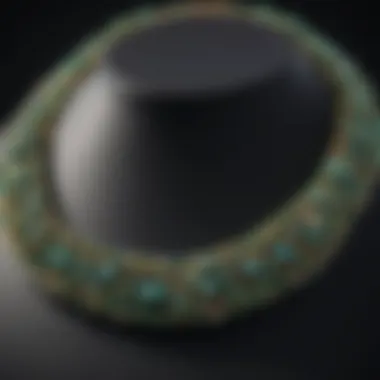
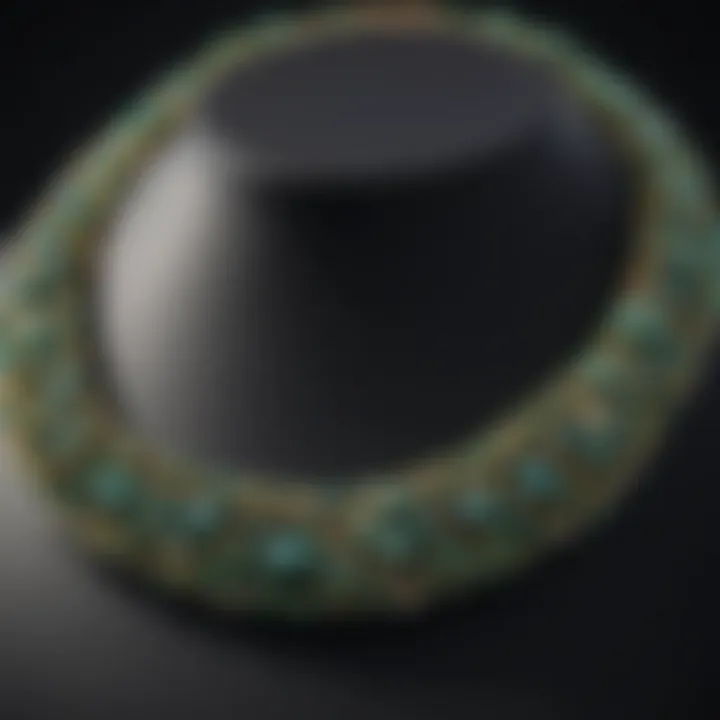
Unique Varieties of Green Pearls
Green Akoya Pearls
Green Akoya pearls are characterized by their brilliant luster and round shape. They are primarily cultured in Japan, and while traditionally known for their white hues, different environmental conditions and cultivation techniques yield green variations. The high-quality luster is a key hallmark of these pearls, making them a popular choice among jewelry designers seeking to create striking pieces.
Their dainty size contributes to their versatile use in fashion. Whether in necklaces or earrings, Green Akoya pearls add a touch of sophistication and elegance. However, they can be somewhat more expensive than other types because of their allure and the precision required in farming them.
Green Tahitian Pearls
Emerging from the warm waters of French Polynesia, Green Tahitian pearls are renowned for their large size and distinctive dark colors. They occur in shades ranging from silver to deep green, with many exhibiting beautiful overtones that can include hues of blue or purple. One should recognize that their robust size and rich coloration set these pearls apart, making them a favorite for statement jewelry.
The uniqueness of Green Tahitian pearls lies in their irregularity of shapes, often giving each piece a bold look. However, these unique qualities can lead to higher price points due to limited supply, particularly for the more sought-after shades.
Green Freshwater Pearls
Green Freshwater pearls are cultivated in freshwater lakes, particularly in China. They are versatile in style, shape, and size, offering a variety of options to collectors and jewelry makers. They often appear in various shades of green, from delicate pastel tones to deep emerald. Their ability to be cultivated in different shapes, including baroque and oval, renders them highly adaptable for distinct fashion styles.
Another attractive feature of Green Freshwater pearls is their generally lower price point compared to saltwater varieties. This aspect appeals to those looking to expand their collection without breaking the bank. Although these pearls lack some luster compared to Akoya or Tahitian varieties, they present a diverse and valuable choice for any jewelry enthusiast.
Formation and Characteristics
Understanding the formation and characteristics of green pearls is central to appreciating these unique gems. The processes that create these pearls not only determine their beauty but also their value and rarity. By grasping the intricacies of how green pearls form, enthusiasts can better appreciate their significance in the world of gemstones. This section will delve into the processes underlying green pearl formation, the defining physical properties that distinguish them, and how these elements contribute to their allure.
The Formation Process
Green pearls begin their life journey inside mollusks, where an irritating substance, often a piece of sand or a tiny parasite, gets trapped. In the case of green pearls, specific conditions in the mollusk’s environment influence the color produced. The layers of nacre are secreted around the irritant, and this natural coating process can take several years. The type of mollusk, water salinity, and even water temperature can affect both the time it takes for a pearl to develop and its resulting hue.
When it comes to green pearls, the hue is often influenced by both organic factors, like the diet of the mollusk, and external factors, including water quality. This complex interplay makes every green pearl a one-of-a-kind gem, contributing to its individual story. Understanding this process helps collectors and jewelers assess the value and unique characteristics of each pearl they come across.
Physical Properties of Green Pearls
The physical properties of green pearls greatly affect their market appeal and desirability. Three primary characteristics stand out: luster, color variations, and shape and size.
Luster
Luster refers to the way light interacts with the surface of a pearl. For green pearls, their luster can be described as soft and glowing, often reminiscent of a serene lake under moonlight. A pearl with a high luster will reflect light beautifully, creating a captivating visual effect that enhances its overall beauty. The luster level is often directly linked to the quality of nacre layers deposited by the mollusk.
- Key characteristic: The shine of a green pearl can vary from bright to muted, influencing its perceived value.
- Benefits: High-luster pearls are typically more sought after, making them a favorable choice for those looking to invest in quality.
- Unique feature: A pearl’s luster can show off the depth of its color and provide a unique depth perception.
Color Variations
The color variations seen in green pearls range from deep forest green to lighter shades that may hint at bluish or gray undertones. The intensity and depth of these colors can vary widely depending on the pearl’s formation conditions and the specific mollusk involved in its development.
- Key characteristic: These variations contribute to the individuality of each pearl, allowing for greater customization in jewelry design.
- Benefits: Diverse color options cater to a broader range of tastes among jewelry enthusiasts, increasing the market appeal.
- Unique feature: Some colors are rarer than others, driving up their value and attracting collectors eager to find striking pieces.
Shape and Size
The shape and size of green pearls can vary considerably, ranging from perfectly round to baroque shapes that provide a more organic appearance. The size can also vary widely, with larger pearls often commanding higher prices due to their uniqueness.
- Key characteristic: Round pearls are perceived as more classic and desirable, while unique shapes can make for interesting and bold jewelry designs.
- Benefits: A range of shapes and sizes allows for creativity in jewelry-making, appealing to a diverse audience.
- Unique feature: The irregularities associated with non-round pearls can enhance their charm, telling a story of natural beauty in each piece.
"Every pearl tells a story, shaped by its environment and the life it led inside the mollusk."
The formation and physical characteristics of green pearls not only determine their aesthetic appeal but also contribute significantly to their economic value and cultural significance. By understanding what goes into the creation of these gems, individuals can cultivate a deeper appreciation for their unique beauty.
The Cultivation of Green Pearls
The cultivation of green pearls is at the heart of the pearl industry and forms a critical component in understanding their value and uniqueness. Unlike mined gemstones, pearls are organically formed and require specific cultivation techniques to ensure their quality and appearance. This has significant implications for both the sustainability of pearl farming practices and the market's growing demand for ethically sourced gems.
Pearl Farming Techniques
Pearl farming is a complex process that involves meticulous care and strategic methodologies. Various techniques can be applied, but some stand out as more effective depending on the types of green pearls being cultivated. The most common methods include:
- Nucleation: This involves inserting a nucleus made of a small bead or piece of tissue into a mollusk. This nucleus will act as the foundation for a pearl to form around it.
- Hanging Culture: Used primarily for larger pearls, this technique involves suspending the mollusks in water to optimize their growth conditions and make harvesting easier.
- Bottom Culture: Ideal for small-scale operations, this technique allows mollusks to grow naturally on the seabed, relying on natural conditions for nourishment and growth.
- Integrated Multi-Trophic Aquaculture (IMTA): Incorporating various species alongside the pearl oysters to enhance environmental sustainability. This method helps improve water quality and encourages diverse marine life.
Effective pearl farming requires ongoing maintenance, from monitoring water quality to controlling diseases and parasites. These factors directly influence the luster and overall quality of the pearl produced. As the saying goes, "you harvest what you sow," which perfectly encapsulates the careful balance between nature's bounty and human intervention in pearl farming.
Environmental Factors in Pearl Growth


The growth of green pearls is highly dependent on a variety of environmental factors. Each variable can significantly dictate the health of the mollusks, which in turn affects the quality of the pearls produced.
Key factors include:
- Water Quality: Clear, clean water is essential. High levels of pollutants or sediment can upset the delicate balance required for pearl formation. Regular monitoring of parameters like pH, salinity, and temperature is crucial.
- Temperature: Most mollusks thrive in warm waters between 25°C and 30°C. Any significant deviations can slow growth rates and even inhibit pearl formation.
- Nutrient Availability: Mollusks rely on phytoplankton and other microalgae as their food source. An abundant food supply can accelerate growth rates and enhance the quality of pearls.
- Salinity: These creatures tend to prefer varying salinity levels, which can influence the nacre quality and coloration of the pearls.
The health of the ecosystem not only supports the mollusks but also ensures high-quality green pearls that reflect the natural beauty of their environment.
Through sustainable practices and a keen awareness of environmental conditions, pearl farmers can cultivate green pearls that are not only aesthetically pleasing but also environmentally responsible. As we further appreciate these exceptional gems, it becomes evident that the magic lies not only in their appearance but also in the careful, respectful cultivation required to bring them to life.
Market Trends and Economic Aspects
The gem market is a constantly shifting landscape. Understanding the market trends and economic aspects related to green pearls not only enhances one's appreciation for these gems but also aids collectors and enthusiasts in making educated decisions. Green pearls’ place in the luxury market is increasingly notable, with various factors driving demand and shaping their valuation.
Current Market Demand for Green Pearls
In recent years, the demand for green pearls has surged, largely due to their unique aesthetic qualities and growing trend among jewelry designers and collectors. Consumers are increasingly looking for distinct pieces that resonate with personal style and values. A few key reasons for this uptick in demand include:
- Unique Color Palette: Green pearls, especially varieties like Tahitian and Freshwater, offer a spectrum of green hues that can't be found in traditional white pearls, creating a strong appeal for buyers seeking something special.
- Cultural Symbolism: Many cultures attribute meanings to colors, and green is often seen as a symbol of renewal and rebirth. This cultural significance has piqued interest in these pearls, particularly among those who appreciate gemstones with a story behind them.
- Sustainability Trends: With more consumers focusing on eco-friendly products, the sustainable sourcing of green pearls has garnered attention. Environmentally conscious buyers prefer gems that support ethical farming practices, making green pearls more attractive.
While the market has its fluctuations, the current trend shows a strong affinity for more uncommon and eco-friendly gemstones, placing green pearls firmly in the spotlight.
Valuation and Pricing Factors
Determining the value of green pearls is an intricate process influenced by a myriad of factors.
- Origin and Type: The source of the pearl greatly influences its price. For instance, green Tahitian pearls are often more valuable than their freshwater counterparts due to their rarity and the intricate farming techniques required to produce them.
- Quality Characteristics: Several qualities play a critical role in valuation:
- Market Trends: The overall economic climate, including shifts in luxury spending, has a direct effect on gemstone prices. Current economic sentiments can cause spikes or drops in demand.
- Rarity: With the increasing focus on unique items, rare varieties of green pearls often see a premium in pricing. Collectors are more than willing to pay top dollar for enough rare finds to complete their collections.
- Luster: Pearls with a high luster command a higher price. Green pearls can exhibit a fantastic sheen that catch's the eye, making them more desirable.
- Surface Quality: Any imperfections, such as blemishes, can significantly impact valuation. Clean pearls with fewer surface flaws hold a higher market price.
- Shape and Size: Round pearls are usually the most sought after and thus the most expensive. Larger sizes are also scarce, contributing to their overall worth.
The charm of green pearls lies not just in their beauty but in the depth of their qualities and the stories they carry in today’s gem market.
In summary, the market for green pearls is vibrant, influenced by trends towards sustainability and a nostalgia for unique, character-filled gemstones. By grasping these dynamics, enthusiasts and collectors can navigate their purchases with more confidence.
Cultural Significance of Green Pearls
The cultural significance of green pearls spans various societies and traditions, highlighting their unique place in the tapestry of human history. These exquisite gems are not just ornamental jewelry; they resonate with deeper meanings, often representing prosperity, renewal, and harmony with nature. Among gemstone enthusiasts and collectors, understanding this significance can greatly enhance the appreciation of these captivating pearls.
Symbolism in Various Cultures
Across different cultures, the symbolism associated with green pearls varies, echoing local beliefs and values. In many Asian traditions, the color green is intertwined with the concepts of growth and fertility. For instance, in Chinese culture, green pearls signify prosperity and good luck, believed to bring harmony to both the material and spiritual realms. Similarly, in some Native American tribes, colors of nature, such as green, embody healing and renewal. Green pearls may be used in ceremonial adornment, reflecting a connection to the earth and its resources.
In the realm of Western traditions, they are often associated with luxury and sophistication. Wearing green pearls can symbolize a deep appreciation for uniqueness and the natural world, appealing to those who value authenticity in design. The lush hue of green resonates with creativity, making these pearls an ideal choice for those seeking to express individuality through their fashion choices.
"Green pearls are more than a mere adornment; they echo the duality of nature, merging aesthetics with spirituality."
Green Pearls in Jewelry and Fashion
In the world of jewelry and fashion, green pearls have carved out a niche that exudes elegance and earthiness. Designers often incorporate these pearls to offer a fresh perspective to traditional jewelry. From earrings to necklaces, green pearls enhance designs with their rich hues and lustrous surfaces, making them a sought-after choice in both casual and formal attire.
The versatility of green pearls is noteworthy. For instance, a simple pair of stud earrings can effortlessly elevate a business casual outfit, while a multi-strand necklace featuring green pearls can serve as a showstopper for an evening event. Moreover, as fashion cycles evolve, green pearls can either complement modern sleek designs or embody classic antique values, bridging generational gaps.
Additionally, the growing trend towards sustainable fashion has revived interest in ethically sourced green pearls. Jewelers and fashion designers are increasingly promoting the story behind their materials, connecting their audience not just to fashion but also to conscious consumerism.
In summary, the cultural significance of green pearls lies in their rich array of meanings and their evolving role in jewelry and fashion. They transcend mere decoration, becoming symbols of heritage, values, and a conscious lifestyle that resonates with a more informed audience.
Metaphysical Properties and Healing Practices
The realm of metaphysical properties surrounding gemstones is as intriguing as the gems themselves. Green pearls, with their distinct hues and shimmering luster, are believed to hold numerous metaphysical attributes that resonate with many. Their qualities aren’t just confined to their aesthetic pleasure; for many, these pearls foster a deeper connection to personal well-being and spiritual journeys. This section seeks to illuminate the uplifting aspects of green pearls, focusing on their healing attributes and applications in meditation.
Healing Attributes of Green Pearls
Green pearls are often associated with healing on various levels—emotional, physical, and spiritual. The color green itself symbolizes balance, harmony, and growth, making green pearls particularly valued in holistic circles. They encourage self-acceptance and forgiveness, guiding individuals through emotional turmoil while promoting inner peace. Those who work with these gems often report feelings of tranquility and balance.
The stone is said to resonate with the heart chakra, aligning with feelings of love and empathy. In practical terms, individuals might hold or wear green pearls during stressful situations, using them as talismans to promote calmness. This is not just hocus-pocus; there's a long history of cultures using gemstones as metaphysical tools.
In addition, some practitioners believe that green pearls can support physical healing by enhancing the body's natural healing processes. Here are some of the reputed benefits:
- Emotional Healing: Helps ease anxiety and promotes emotional stability.
- Physical Welfare: Supports the immune system and stimulates detoxification.
- Spiritual Growth: Assists in developing a greater understanding of oneself and one’s connections to the universe.
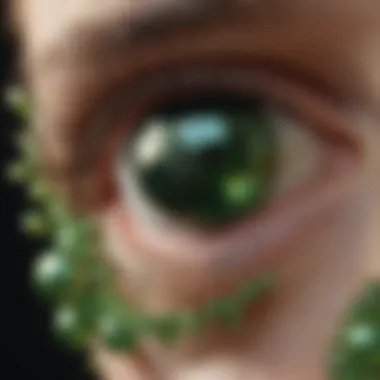
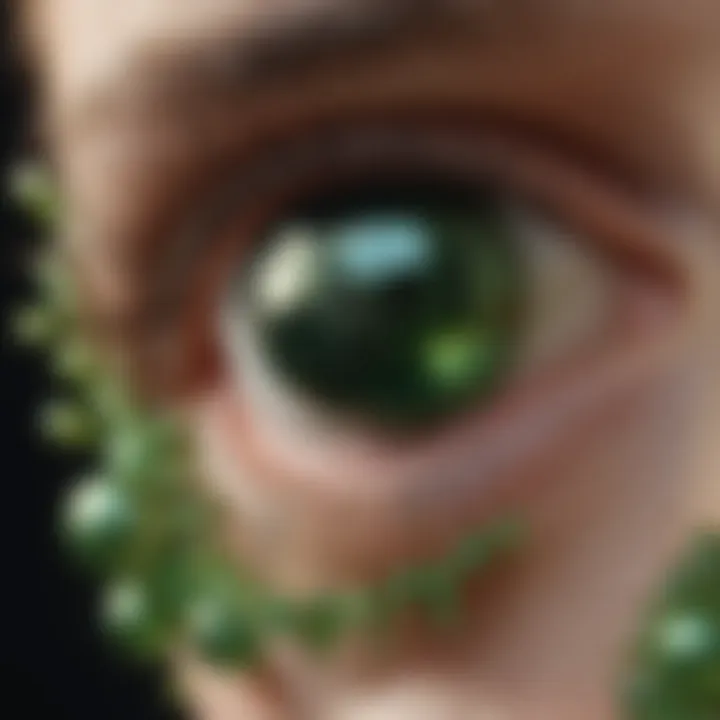
"The heart of a pearl can help mend shattered dreams and restore lost hope."
Meditative Uses of Green Pearls
Meditation is another avenue where green pearls shine bright. Incorporating them into meditative practices can deepen one’s experience, fostering a sense of grounding and focusing energies. Many meditation enthusiasts find that having a green pearl nearby can enhance concentration, allowing for a more profound connection during sessions.
Using green pearls in meditation can take many forms:
- Holding or Wearing: Some individuals simply hold the pearl in their hand or wear it as jewelry to keep its energy close.
- Chakra Alignment: Focus on the heart chakra, envisioning the green pearl energizing this center, promoting love and compassion within oneself and towards others.
- Guided Imagery: Visualize the green pearl as a glowing source of light during meditative practices, radiating peace and healing energy throughout the body.
Authenticity and Quality Assessment
Assessing the authenticity and quality of green pearls stands as a cornerstone in the appreciation and valuation of these unique gems. As the market continues to exhibit a growing interest in green pearls, understanding how to identify genuine specimens and evaluate their quality becomes crucial for enthusiasts, collectors, and jewelry designers alike. This section delves into the processes that assure buyers they’re investing in authentic green pearls, highlighting the key factors to consider during evaluation.
Identifying Genuine Green Pearls
To accurately identify genuine green pearls, one must become familiar with certain distinguishing characteristics. Unlike synthetic pearls, which are artificially made, genuine green pearls are formed by natural organisms and reflect an array of traits shaped by their environment and formation process.
Here are some primary tips for recognition:
- Surface Examination: Genuine pearls often exhibit slight imperfections on their surface, including bumps or irregularities. The presence of these natural tattoos indicates authenticity, since cultured or artificially crafted pearls typically have a flawless sheen.
- Luster Quality: A true green pearl will possess a deep, rich luster that seems to change with light. A dull or overly shiny surface often suggests a synthetic origin.
- Weight and Feel: Real pearls feel weighty compared to their size. When held, they typically feel cooler to the touch than glass or synthetic materials.
- Nacre Thickness: This refers to the layers that form the pearl. Genuine pearls have a thicker nacre, contributing to their durability and unique luster. A simple scratch test can provide insight; authentic pearls will resist scratches due to their dense structure.
"The allure of a green pearl lies not just in its beauty but also in its story—the unique journey it underwent in the depths of the ocean."
Grading and Certification Processes
When it comes to purchasing green pearls, understanding the grading and certification processes is indispensable. Grading systems help buyers gauge the quality and value of pearls, ensuring transparency in the market. Various organizations utilize specific criteria to assess pearls, and these assessments are essential for both consumer protection and investment security.
Key elements that impact grading include:
- Luster: The brightness or sheen of the pearl is vital for determination of its quality. Pearls are rated from dull to high luster, with the latter being most desirable.
- Shape: Different shapes, from round to baroque, carry varied value. Round pearls typically command higher prices due to their rarity.
- Color and Overtones: The hue is fundamental in grading. Pure green shades are rare, while those with overtones—like blue or gold—may enhance a pearl’s beauty and price.
- Surface Quality: A thorough check for blemishes or marks also plays a role in the grading process. Pearls with fewer surface imperfections receive higher ratings.
Buying from reputable sources, be it jewelers or online platforms, can further ensure that the pearls are certified, often accompanied by documentation that details their quality grade.
In summary, authenticity and quality assessments in the domain of green pearls are pivotal not just for preserving the integrity of the trade, but also for guaranteeing that collectors and enthusiasts alike receive splendid examples of nature's craft.
Ethical Sourcing and Sustainability
In the modern world, conversations surrounding ethical sourcing and sustainability have taken center stage, particularly in industries connected to natural resources. When it comes to green pearls, this topic becomes indispensable. Not just a matter of business ethics, ethical sourcing encompasses the methods and practices that ensure the welfare of both people and the environment involved in the pearl farming process.
To a casual observer, pearls may seem like simple adornments, yet their journey from ocean to ornamentation holds profound implications. Understanding the practices of pearl cultivation helps shed light on the broader issues of environmental responsibility and equitable trade.
Environmental Impact of Pearl Farming
The cultivation of pearls isn't without its ecological footprint. Pearl farming, often conducted in coastal regions, can significantly affect marine ecosystems if not managed correctly. Factors like water quality, local biodiversity, and the health of the ocean floor are all tied to how these farms operate. As such, sustainable techniques are increasingly essential.
For instance, employing less invasive farming methods can stem the degradation of marine habitats. Some farms are exploring integrated multi-trophic aquaculture (IMTA), where multiple species are farmed together in a manner that one species' waste supports another's growth—effectively creating a mini-ecosystem.
“Ethical practices in pearl farming not only protect the environment but also enhance the quality of pearls produced.”
Through sustainable initiatives, such as reducing the use of harmful chemicals or adopting eco-friendly farming techniques, pearl farmers can protect delicate marine ecosystems. Moreover, promoting healthy oyster populations indirectly contributes to water cleansing—an underappreciated benefit of thoughtful pearl farming.
Ethical Considerations in Pearl Trade
Shifting gears to ethical considerations in pearl trade, the conversation encompasses fair labor practices and community relations. Pearl farms situated in economically developing regions can sometimes engage in exploitative labor practices. Fair trade practices aim to counter this by ensuring that the workers involved are treated decently and compensated fairly.
- Transparency is vital in the supply chain. Consumers are increasingly demanding to know where their pearls come from, and whether they are ethically sourced. This growing awareness encourages brands and retailers to share their sourcing stories openly.
- Community development initiatives can further enhance the impacts of ethical sourcing. When local communities benefit, either through improved wages or sustainable job creation, the entire ecosystem—social, economic, and environmental—thrives.
Navigating the waters of ethical pearl trade isn't straightforward, but by aiming for good governance and promoting practices that benefit both the environment and local communities, the industry can move toward a more sustainable and equitable future. The beauty of these gems today is not just in their appearance, but also in the values embedded in their journey at sea.
Finale: The Enduring Allure of Green Pearls
The exploration of green pearls reveals their significance far beyond mere aesthetics. This conclusion serves as a reminder of the gems' multi-faceted nature that encompasses cultural, economic, and metaphysical dimensions. Understanding these elements helps enthusiasts and collectors appreciate what these unique gems offer in their entirety.
The importance of green pearls lies in their rarity and beauty, coupled with their historical context and the stories they carry. Cultured and natural varieties alike reflect human ingenuity and the timeless allure of nature’s treasures. As pearl farming evolves, so too does the effort to ensure sustainable practices that honor ecological balance.
From a market perspective, green pearls have increasingly become a focal point for jewelry designers and collectors. The fluctuating demand not only drives prices but also sparks discussions about the future of pearl sourcing.
Additionally, the cultural significance ascribed to green pearls speaks to the human connection with nature. Here are some benefits of this enduring allure:
- Cultural Richness: Green pearls symbolize various values and beliefs across cultures, embodying themes from prosperity to harmony with nature.
- Aesthetic Appeal: Their unique colors and finishes appeal greatly in modern fashion, making them favored choices for both everyday and formal jewelry.
- Metaphysical Attributes: Many believe in the healing properties of green pearls, enriching personal well-being and mental peace.
- Economic Value: As market trends shift, being informed about the valuation of green pearls provides opportunities for collectors and investors alike.
"Green pearls are not just gems; they are carriers of culture, beauty, and advancement in the world of jewelry and beyond."
Having traversed the captivating landscape of green pearls, the enduring allure of these gems emerges clearly. Their uniqueness, heritage, and contemporary relevance ensure that they will remain in the spotlight for time to come.



